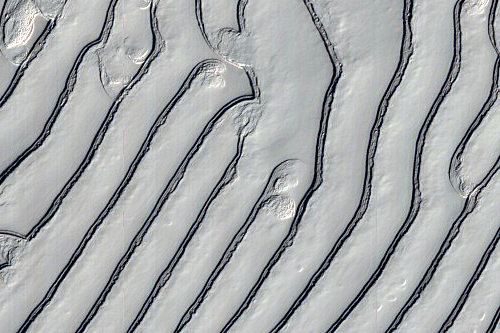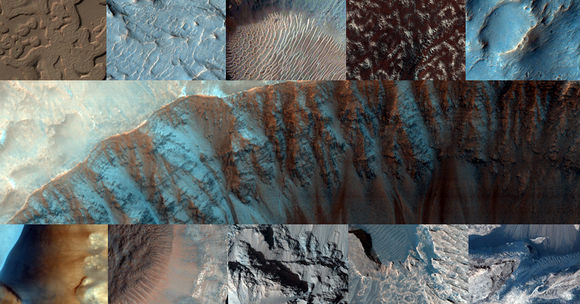[/caption]
We frequently ooh and aah over the images returned by the HiRISE camera from the Mars Reconnaissance Orbiter, and now there’s gonna be a whole lot of oohing and aahing going on. The HiRISE folks have just released more than 1,500 new observations of Mars for the Planetary Data System archive, showing a wide range of gullies, dunes, craters, geological layering and other features on the Red Planet. Take a gander at some of the highlights:

This is one of my favorites, “Colliding Sand Dunes in Aonia Terra. See a “movie” of it here.
These images were taken during months of April through early August of this year. The camera team at the University of Arizona releases several featured images each week and periodically releases much larger sets of new images, such as the batch just posted.
See all the new images, available here.
Each full image from HiRISE covers a strip of Martian ground 6 kilometers (3.7 miles) wide, about two to four times that long, showing details as small as 1 meter, or yard, across.
Here’s another favorite; patterns in CO2 ice on Mars:

Meanwhile, engineers are still trying to determine what caused MRO to go into safe mode about a week ago. This has happened several times, and mission managers are intent on getting to the bottom of the problem.
To help in identifying a root cause in case of a recurrence, engineers have programmed the spacecraft to send back a higher rate of data, and to frequently record engineering data onto non-volatile memory. That large amount of data now being received could give an improved record of spacecraft events leading up to the latest reboot.
The Mars Reconnaissance Orbiter currently has normal power, temperatures and battery charge. It remains in proper sun-pointed attitude and in high-rate communication with Earth. Safe mode is a precautionary status that spacecraft are programmed to enter when they sense conditions for which they do not know a more specific response. While in this mode, a spacecraft suspends non-essential activities pending further instructions from ground controllers.
“The spacecraft is stable and our priority now is to carefully work our way to understanding this anomaly, with the intent of preventing recurrences,” Mars Reconnaissance Orbiter Project Manager Jim Erickson, at NASA’s Jet Propulsion Laboratory, Pasadena, Calif., said Friday.
For more information about the mission, visit the MRO website.


Your MRO website link includes a period at the end, which causes an error page at the NASA website. It should be http://www.nasa.gov/mro
Thanks Mike!